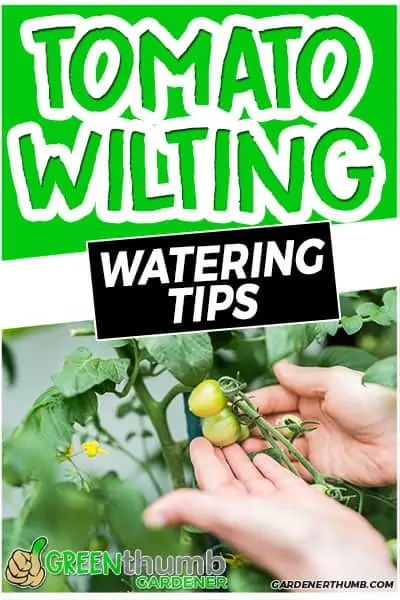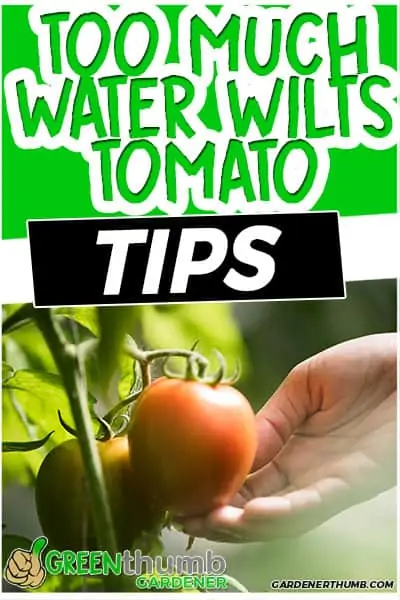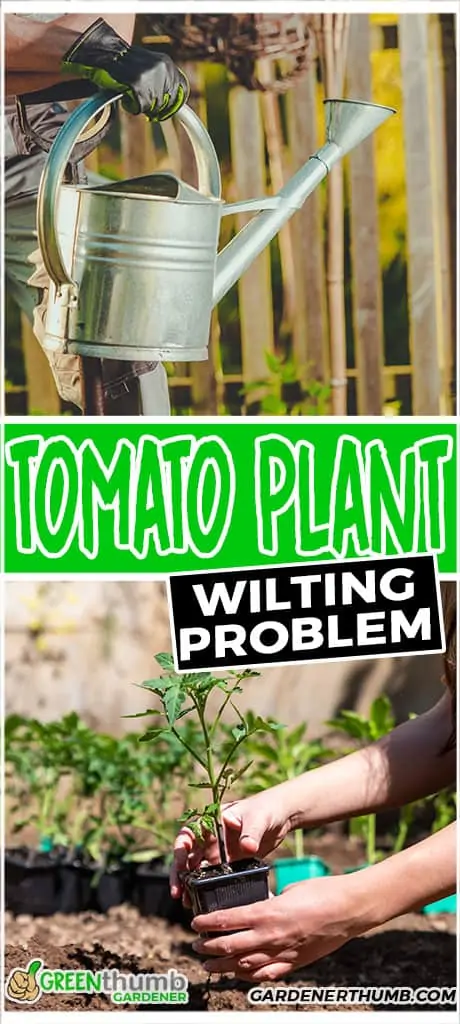Your Tomato Plants Wilting | Too Much Water Issues
Last updated: 06/07/21
My tomato plant leaves and stems were wilting and I wondered if it could be from too much water or if there was another reason behind it. I was worried that my plants were going to die, and I knew I had to do something to save them.
Wilt is the most common symptom of an unhappy tomato plant and I knew it could lead to the plant dying if I didn’t take action.
My tomato plant leaves and stems were wilting and I wondered if it could be from too much water or if there was another reason behind it. I was worried that my plants were going to die, and I knew I had to do something to save them.
Wilt is the most common symptom of an unhappy tomato plant and I knew it could lead to the plant dying if I didn’t take action.
Green thumb Gardener occasionally links to product and/or services offered by vendors to assist you with all your gardening needs. Some of these may be affiliate links, meaning we earn a small commission if items are purchased.
Want to Download a Garden Hack Guide for FREE

Enter your email below and we will send you a guide to help you SAVE money in your garden.
Temperature
Hot conditions can cause tomatoes to wilt. When temperatures are high, it can place stress on tomato plants, especially if they have not been watered recently.
This type of droopy tomato plant should recover on its own as long as it is in moderately moist soil. Overly dry soil baked by the hot sun will result in a weaker, less robust plant and inferior tomato fruits, so it’s important to make sure your tomatoes receive enough water.
Overwatering And Underwatering
It might seem strange that too much water and not enough water could both cause the same symptom in tomatoes, but it’s true that both can cause the plants to wilt.
Muddy soil is a sure sign of over watering, which will prevent the plant from taking in water because the roots are already waterlogged. Puddles on the surface of the soil the tomato is planted in also indicate too much water.
Underwatering will also cause tomatoes to wilt and droop. A good practice is to water your tomatoes once a day, in the morning before the day gets too hot.

However, if it is a rainy day or your tomatoes already appear to be well watered, you may not want to add extra water that day.
Observing the conditions your tomatoes are in will help you decide what to do.
Fungal Wilt In Tomatoes
Tomato wilt can be caused by several pests and diseases that create different forms of wilt. The most common of these are the fungal wilt diseases fusarium wilt fungus and verticillium wilt.
Both of these types of wilt will cause the tomato plant to wilt during the day and then seemingly recover at night, but the plants will eventually wilt permanently until they are dead.
Fungal growth, caused by these soil-borne fungal diseases, cannot be diagnosed until the entire infected plant is dead and the stem is cut open to reveal brown discoloration.
What To Do With This
If your tomatoes experience any of these fungal infections, pull them up and destroy the plants, so the fungus cannot survive and damage future plants. It is important not to compost the dead plant material.
You may want to burn the plants if that is an option in your area, or dispose of them so that they will not be able to infect any other plants or soil.
The following year, you should plant resistant varieties, marked in seed catalogs with an F (for fusarium wilt resistance) or a V (verticillium wilt resistance).
You may also want to plant tomatoes in a different place in your garden to rule out the transfer of any fungus in the soil. Rotating your plants to different beds is a good practice anyway, since growing the same one year after year in the same spot will deplete the soil’s nutrients.
Viral Wilt in Tomatoes
Tomato spotted wilt virus is another infectious wilt that can also cause wilting along with other symptoms. With these viral infections, the leaves may appear bronze, the plant may have stunted growth, and the tomato fruit may develop green or brown ring-shaped marks.
The leaves may also develop necrotic (dead) spots and may cup downward. This virus is transmitted by thrips, slender insects that feed on the juices of plants and scrape leaves and flowers, causing damage.
Viral tomato wilt can also be transmitted to other plants, including onions, other crops, and even ornamental plants and weeds.

Bacterial Wilt in Tomatoes
Bacterial wilt can also cause wilt and lead to the death of the tomato plant. With bacterial wilt, the newest or youngest leaves are most affected, though the leaves will remain green.
Cutting the stem, you will see a white substance instead of the brown discoloration that comes with fungal wilt diseases.
This type of wilt is more common in sandy soils. It can also transfer to other plants including those in the same family, Solanaceae, including eggplants, tobacco, and potatoes.
Pests
Pests can also cause tomato plants to wilt. Stalk borers are a common pest which burrow into the tomato plant stalk and feed on the vessels that transport water throughout the plant.
You may not even be able to see the hole where the larval borer caterpillar entered the stem, as they are very tiny at that stage. In some cases, with plenty of care and attention, a tomato plant with a stalk borer infestation can still live and produce fruit.
Regardless of whether the plant produced fruit, though, if you discover borers, you should always destroy the plants rather than compost them. This will interrupt the life cycle of the tomato stalk borer.
Root-knot nematodes, another pest of tomato plants, are very small and wormlike. These root-knot nematodes live in the soil and feed on the tomato roots. This pest attack causes root damage which hampers the plant’s ability to take up water and nutrients.
This causes wilt in tomatoes as they do not get the nourishment they need to grow and develop healthy fruit. Tomatoes with root-knot nematodes should be destroyed as well, to attempt to prevent future infestations.
Trees
Another cause of tomato wilt is the toxin juglone, which is produced by black walnut trees. To avoid this, grow your tomatoes at least 75 feet (23 m) away from any walnut tree.
If you do not have adequate distance available, you can grow your tomatoes in a raised bed with a barrier layer or in containers, to avoid contact with the toxin. Be sure that no walnuts, husks, twigs, or leaves are allowed to fall and remain in the raised bed or container.
If you put any material from the black walnut tree in your compost pile, be sure the compost has been fully composted before using the compost with your tomato plants. This may take at least six months or even a year depending on how your compost pile cooks.
Signs of Overwatering Your Tomato Plant
It’s not too hard to tell when you’re overwatering your tomato plant. When you look at an overwatered plant, you may see cracks in the tomato fruit and bumps on the lower leaves. If the soil around the plant is squishy or has puddles of water on the surface, the entire plant is overwatered.
Slightly moist soils are ideal but wet soils indicate overwatering.
You may also see that the plant is wilting and the leaves are curling or rolling up. You may notice yellow leaves, a sure sign of improper watering.

Further Reading
What To Do To Save An Overwatered Tomato Plant
Don’t fret if you have an overwatered tomato plant. There are several things you can do to save it.
Sometimes Mother Nature does the overwatering for you!
If the weather is rainy and your outdoor plants are getting too much water, you can use plastic sheets to protect the plants.
This type of overly moist weather means that you won’t need to water yourself, but you will need to protect your outdoor tomato plants from excess moisture using moisture regulators such as plastic sheeting to cover and protect the plant and its roots from too much water.
For an indoor plant, you can monitor the watering more carefully. If your container plant tomatoes are overwatered, you can fix the situation with a few steps.
One option is to remove your potted tomato plant from the container with care and let the plant dry with a little fresh air and sunlight. Then repot your plant taking care to use fresh potting soil that isn’t waterlogged.
Since you will be doing manual watering, you can carefully control the amount of water your houseplants receive. To water tomato plants, you want to be sure not to give too much or too little.
It can be useful to set up a watering schedule, so you know you have adequate watering (but not too much!).
Proper Tomato Watering Tips & Techniques
To keep your tomatoes healthy, it is important to use time-tested techniques and tips from expert gardeners.
Experienced gardeners generally expect to provide about one inch of water per week for a tomato plant, but that can vary depending on the weather and the type of soil you have.
Many gardeners use a guideline that the soil around a tomato plant should be moist to about two to three inches down. If the soil is dry two to three inches down, the plant needs more water.
Final Thoughts
Correct watering for tomato plants can be the key to beautiful plants with tasty tomato fruits. The best way to ensure that your tomato plants are healthy is to observe them and take note of any symptoms like wilting.
That way you can respond appropriately by giving the tomatoes just the right amount of water and keeping an eye out for any pests or diseases that might be affecting them.
Watching tomatoes grow and thrive will surely bring happiness to any gardener!
Related Questions
Will Overwatered tomato plants recover?
Yes, overwatered tomato plants will recover if the roots are allowed to dry out enough that they are no longer waterlogged.
Should I water tomatoes daily?
Yes, you should water tomatoes at least once a day unless they are getting enough water from rain or have been overwatered already.
Can overwatering cause tomato leaves to curl?
Yes, overwatering is one thing that can cause tomato leaves to curl.








